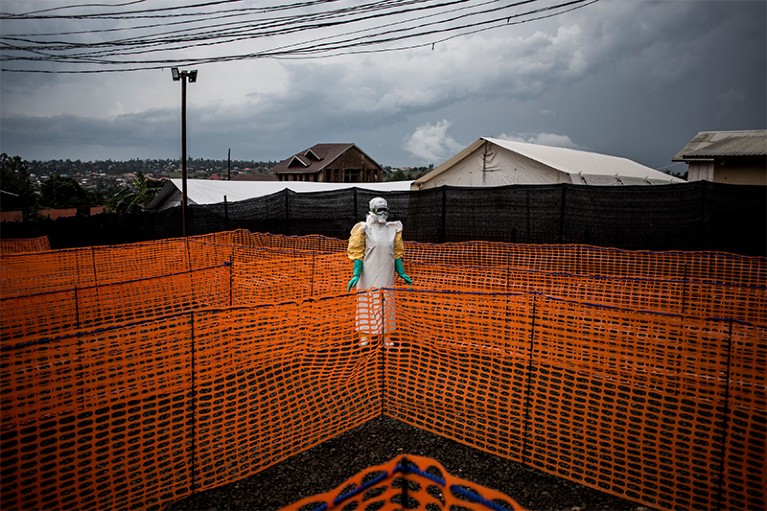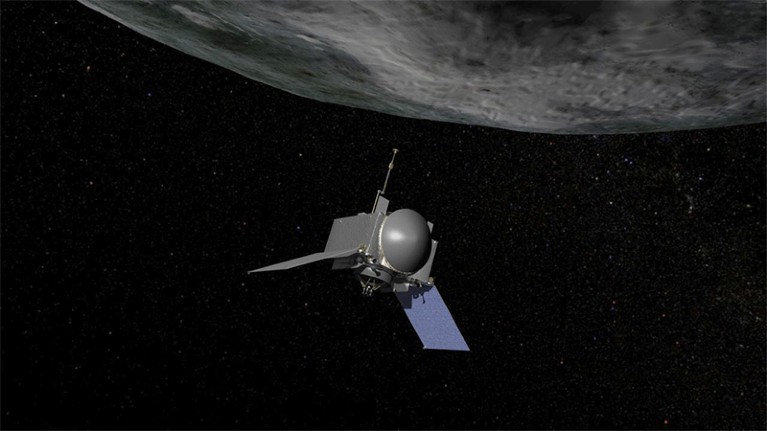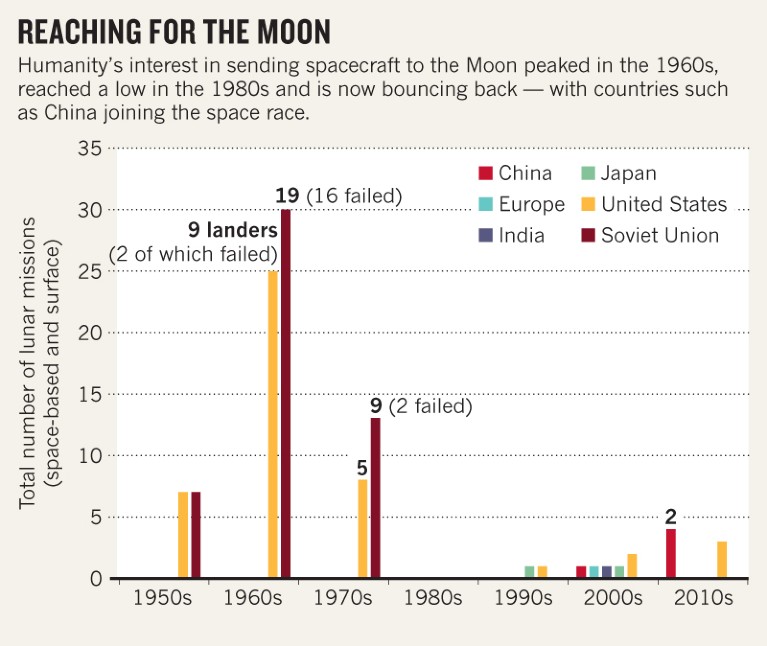HEALTH
Ebola outbreak hits bleak milestone The ongoing Ebola outbreak in the Democratic Republic of the Congo (DRC) is now the second largest on record, according to the World Health Organization. “This is a milestone nobody wanted to hit,” said a spokesperson for the agency in an e-mail to Nature. With 444 total cases, including 260 deaths, as of 2 December, the outbreak is larger than the 9 others recorded in the country since 1976. It is still smaller than the 2014–16 Ebola crisis in West Africa, which resulted in more than 28,000 cases, including about 11,300 deaths. As the DRC outbreak spreads into cities whose inhabitants are living amid conflict, and with refugees regularly moving around the region and into the neighbouring countries of Uganda, South Sudan and Burundi, officials warn that the situation is unpredictable and that the outbreak will continue well into next year.

A health worker waits outside an Ebola treatment centre Bunia, Democratic Republic of the Congo.Credit: John Wessels/AFP/Getty
CLIMATE
El Niño forecast There’s a 75–80% chance that a weak El Niño weather pattern will develop between December 2018 and February 2019, according to the World Meteorological Organization (WMO). Researchers don’t expect the upcoming El Niño to wreak as much havoc as did the monster 2015–16 event, which flooded parts of South America and sparked worldwide coral bleaching, among other things. But even a weak El Niño could boost global temperatures and lead to increased rainfall in areas such as the southeast coast of South America, the WMO said on 27 November. Sea surface temperatures in the central and eastern tropical Pacific warmed to weak El Niño conditions in October. Researchers predict that the atmosphere will respond to the increased temperatures with changes in wind and cloud patterns in the coming months.
Drastic action Governments of the world need to triple their current efforts to reduce greenhouse-gas emissions to prevent global warming of more than 2 °C above pre-industrial levels by 2030, the United Nations Environment Programme (UNEP) said in its annual ‘emissions-gap’ report. Released on 27 November — just a week before the latest UN climate summit in Katowice, Poland — the report projects that current national policies would allow global greenhouse-gas emissions to rise by around 10% by 2030, compared with 2017 levels. But emissions would need to decrease by 25% over the same period to maintain a probable chance of limiting warming to 2 °C. Nations would need to reduce emissions by 55% to restrict warming to below 1.5 °C.
FACILITIES
Oil surveys The US National Marine Fisheries Service will allow five companies searching for offshore oil to use a technique to that can harm animals such as whales and dolphins. Air-gun blasts used in these surveys create powerful sound waves — which can be louder than a Saturn V rocket at launch — that help to map oil and gas deposits below the sea floor. The authorizations, issued on 30 November, limit when and where air-guns can be fired along the US east coast. They also include monitoring and reporting requirements to help mitigate the survey’s impacts on marine mammals, which are protected under a 1972 law. The authorizations are the first step of a two-part process as US President Donald Trump seeks to open coastal waters to oil exploration. The Bureau of Ocean Energy Management must now issue permits before the surveys can begin.
POLICY
Gene-drive treaty Nations rejected a proposal to temporarily ban the release of organisms carrying gene drives — a genetic-engineering technology designed to spread mutations rapidly through a target population — on 29 November at a meeting of the United Nations Convention on Biological Diversity (CBD) in Sharm El-Sheikh, Egypt. Dozens of scientists opposed the moratorium proposal, although numerous environmental and activist groups supported it. A gene-drive moratorium was never likely to succeed in the face of opposition from biotechnology-friendly countries, because changes to the CBD require a consensus among the convention’s almost 200 parties. Instead, representatives at the two-week-long meeting agreed on changes that were vague enough for both proponents and sceptics of gene-drive technology to claim victory. Signatories to the CBD, which has been ratified by most of the world’s countries and influences national laws that affect biodiversity, agreed on the need to assess the risks of gene-drive releases on a case-by-case basis. They also said that local communities and Indigenous groups potentially affected by such a release should be consulted.
SPACE
Asteroid arrival NASA’s OSIRIS-REx spacecraft arrived at its target, the 500-metre-wide asteroid Bennu, on 3 December after a nearly 27-month journey. The probe will now loop around Bennu to study it until 2020. Then, in July of that year, OSIRIS-REx will lower itself to the asteroid’s surface, pick up at least 60 grams of asteroid dirt and fly the sample back to Earth. It is scheduled to return in 2023. OSIRIS-REx — or Origins, Spectral Interpretation, Resource Identification, and Security–Regolith Explorer — also aims to study the factors that affect the paths of potentially hazardous asteroids. It will be the first US mission to return to Earth after collecting an asteroid sample.

Artist’s concept of OSIRIS-Rex at Bennu.Credit: NASA/Goddard
Black-hole bounty Astronomers have announced the detection of four new gravitational-wave events — ripples in the fabric of space-time created by cataclysmic cosmic events. The signals, detected in 2017, were created by mergers of black holes, and include hints of the largest such merger yet, which produced a black hole more than 80 times as massive as the Sun. The studies were posted on the website of the US-based Laser Interferometer Gravitational-Wave Observatory (LIGO) collaboration. The experiment — which announced its first historic detection of gravitational waves, from a black-hole merger, in 2016 — has now detected ten such events, as well as one collision of two neutron stars that produced the strongest gravitational-wave signal yet.
PEOPLE
French connections A controversy over the leadership of France’s national biomedical-research agency INSERM ended on 26 November with the news that the government had appointed Gilles Bloch, president of the University Paris-Saclay. Bloch succeeds Yves Lévy, who had sought a second four-year term as INSERM chief, but pulled out for “personal reasons”. Lévy’s leadership, which began in 2014, had become controversial after his wife, Agnès Buzyn, was appointed health minister in 2017 — although procedures were put in place to mitigate a possible conflict of interest between the two. Bloch will take up the post on 2 January.
Science minister Britain’s universities and science minister, Sam Gyimah, resigned on 30 November after Prime Minister Theresa May said that the country would not seek to continue using Galileo, the European Union’s satellite-navigation system, after Brexit. Britain’s future participation in Galileo has been a sticking point in Brexit negotiations: the UK government had intended to negotiate rejoining the system, but EU law dictates that a non-member state cannot be involved in developing the secure part of the system, which provides signals for government users, including the military. Gyimah also said that he would vote against the Brexit divorce deal — which defines the terms of the country’s exit — when it comes before Parliament on 11 December. The deal, agreed last month between UK and EU officials, has divided politicians and prompted a spate of ministerial resignations. Gyimah became science minister in January. His replacement, Chris Skidmore, was appointed on 5 December.
PUBLISHING
Open-access push More than 1,400 researchers have signed an online letter supporting Plan S, an initiative backed by 16 research funders that mandates that, by 2020, papers resulting from their funding should be free to read instantly on publication. The petition, launched on 28 November by Michael Eisen, a geneticist at the University of California, Berkeley, comes as scientists continue to debate the European-led plan. A letter published 3 weeks earlier — which has more than 1,400 signatures — had called Plan S “a serious violation of academic freedom”, because it would prevent researchers from publishing where they wanted. But Eisen’s petition argues against this, and says that although funder mandates might “superficially limit our publishing options in the short term”, they would ultimately lead to a system that maximizes the reach of scholarship and its value to all.
TREND WATCH
On 8 December, Chang’e-4 will set off to become the first spacecraft to touch down safely on the Moon’s far side. Half a century after the original space race, there has been a resurgence of interest in Earth’s satellite, with some scientists saying we are entering a renaissance of Moon exploration.
The United States and the Soviet Union conducted a large number of lunar missions — many unsuccessful — in a race to prove dominance in space exploration. These culminated with the Apollo missions that put humans on the Moon in 1969. After the excitement of the space race, it went quiet. The Soviet Union sent its final mission to the Moon in 1976, and budgetary issues and a lack of political will in the United States led to missions being cancelled.
But the past two decades have seen a gradual return of lunar missions. Some dozen of these orbiters have been launched since 1990, by the United States, but also by new players such as China and Europe. Landers are also back in fashion. In 2013, Chang’e-3 became the first mission to land on the Moon since the 1970s. Chang’e-4 will follow, and landers from Japan and Russia are also planned.

SOURCE: NASA






